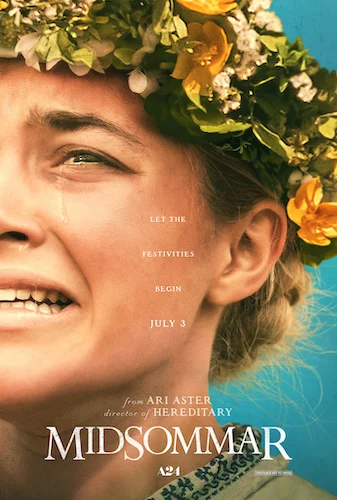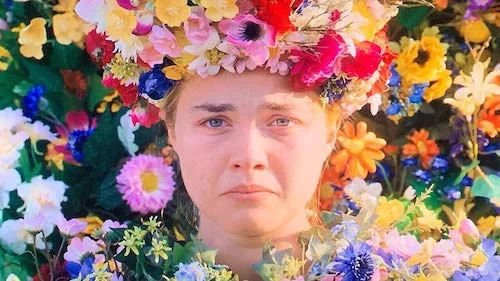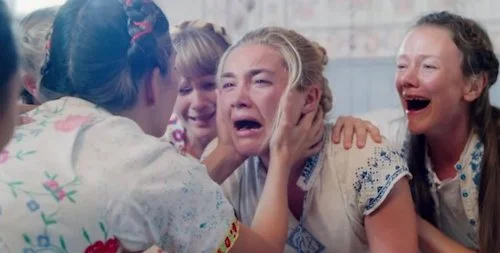Midsommar
By the time I was finished with Ari Aster’s latest domestic horror flick, I was conflicted. Do I tear up because of the overwhelming artistry that I had just witnessed for two and a half hours, or do I vomit because of the images I had endured? Life is full of mixed emotions (a lesson we learned from Inside Out!, and hopefully before), but not many directors can pull off the complexities of grief like Aster. Hereditary was the fear of having your family slowly slip away from you against your control. The final twist in that film explored the ideas of the powers that be. Well, that final moment almost felt like homework for Midsommar: a nightmare that flirts with the marriage between sanctity and savagery very often. We have another tale of grief, with the lead character Dani dealing with extreme death right off the bat.
What follows cannot even be described as the trip down the rabbit hole. Part of grief is understanding what our own thresholds are. In Midsommar, the line gets crossed extremely quickly, and the majority of the film becomes a testament of how far you yourself can cope. Imagine Dani, whose entire family gets stripped from her, because she thought her sister was just having another episode. Does death become better when it is turned into a part of the living experience? Does that make demise something to cherish? When removed from the comfort of her own stomping grounds, Dani experiences the rituals of a remote community in Sweden during her darkest hour. Ironically, she is up north enough that the sun rarely ever sets. There is no hiding behind shadows or darkness. Everything you see is in broad daylight. And they say the dark is scary.
The use of nature — especially flowers — turns people into beings that bloom and perish, as the world intends.
Dani is on this trip because her boyfriend (Christian) had planned to go on it with his fellow anthropology cohorts. The idea of concocting a thesis in this community is one that makes us understand immediately that there will be a separation between this festival and our norm. I honestly don’t know how to dig deeply into this film without spoiling, so the spoiler tags are going to be tossed up soon. Just understand this: it is not a fun time. It was never going to be a fun time. What Midsommar provides, however, is a jarring depiction of the human experience in some of the most extreme methods of the year. If you have are easily squeamish, I would recommend staying far away or bringing five sick bags. If you want a challenge, go ahead. Don’t say I didn’t warn you. Either way, expect to be repulsed, but I also wish to bring up the power this film brings when it comes to living the lowest depths of the emotional sepectrum. Aster is a genius, and he has done it again (and even better).
One of the many drawings left throughout the film, which encourages a rewatch to even catch half of them.
SPOILERS
MATURE CONTENT
Midsommar is all about the nature of life. Roots dig themselves into the ground. Vegetation rises above, but eventually topples. Plants rot, and get sucked back into the ground. New life grows. That’s what this community follows closely. They view life as a cyclical, ritualistic function as a whole (so actual rituals do not take place within their lives. It’s a bit of a difference). Everything has to go according to plan. Life is planned: we conceive when ready, or we take on our parental duties when the time is right. This community views death the same way. We have to die at the end of the fourth cycle. It’s why the suicide ritual takes place. It’s why none of the members flinch, yet every invited outsider winces and keels over. The feast on the second day was the last supper for those two sacrificed elders, so the community had to eat when they ate (they had to command the lead).
You can analyze this level of detail in all of these intrinsic rituals. Hair is a growing, sprawling system that works like roots do (they have entrenched bases, and visible parts outside of the layerings below). Hair is important, especially when it comes to fertility. The consumption of genital follicles is essential to this group. For us? It’s nauseating, and beyond description. This is still one of the many steps that must take place during this nine day ceremony. The sun rarely sets, so days seep into one another. I could swear I counted six days, but we could have easily reached nine without me knowing. Maybe we didn’t see all nine days. Maybe you’re meant to be thrown off. Much of Aster’s film is a means of creating instability, so you are never quite sure of where you truly are.
Christian responding to ritualistic requests.
Dani wants an escape to overcome her crippling grief. Instead, she faces some gruesome events. The ritualistic suicides (and the final blows for those who survive the great fall). The consumption of pubic hair and menstrual blood. The ingestion of hallucinogenic drugs that give her bad trips. Her loved one cheating during a symbolic conception service. Then there’s all the stuff she didn’t see: the wearing of other peoples’ faces, the butterfly disembowelment of an unwilling participant, the stuffing of organic materials in emptied corpses, and every other damn thing we went through. Good lord, you won’t find many films topping how insane this one is.
That’s what Aster is going for, though: the damnation caused by the death of loved ones. In this society, death is welcomed. In fact, it is planned. All of the drawings everywhere insist that we follow this order. We are born. We love. We conceive. We expand a family. We die when instructed. This is a welcoming family to those that want to be there. Dani and company do not want to be there. This is disgusting from an outsider perspective. As Ingmar (possibly a reference to Bergman and his use of showing religious unorthodoxy in his films) states, this is how things go here. As brought up, Americans putting elderly citizens into old age homes is probably unethical to this community, and yet we do it. Can we really compare that to the shoving of a skinned body through the trunk of a tree? I don’t think so, but it’s an argument this family is willing to make.
A pivotal moment where Dani’s depression results in a hysteria of cackles and wails.
What’s key is the idea of family. Dani no longer has one, and she is aware that her boyfriend is both toxic and distant. Even though she was brought in against her will, Dani ends the film with comfort. She finally has a family, no matter who it is. Whenever the “f” word was brought up before, she would break out into a panic attack. Now, she smiles. She is brainwashed. She is now long gone. She is happy. She avoided sacrifice by winning the competition, so she is being welcomed. Everything else is twisted: the incestuous process of having disfigured or ill offspring, the amalgamation of corpses with vegetation, the forced removal of virginity before one may be naturally ready. Dani came from a toxic family. She somehow feels at peace with this place by the end of the film, and it’s scary.
END OF SPOILERS AND MATURE CONTENT
There are so many elements to pick apart, especially the symbols. The cinematography by Pawel Pogorzelski is so unsettling (especially the crane shots that glide and flip upside down). Mix that with the nerve wracking score by The Haxan Cloak, and you will feel sick before anything even happens. Midsommar is so gut wrenching, because of how unique of an experience it is. Sure, you can compare it to The Wicker Man (the good one), but do you want to stoop that low? This is beyond just being a pagan horror. What we truly have is the uncomfortable face-to-face discussion with the human experience. It’s bloody, repulsive, depressing, frightening, and very real. Midsommar is artistically outstanding. Aster’s screenplay is so meticulously pieced together. You know the film isn’t just trying to shock you for cheap thrills. You know everything serves a purpose, whether it’s to Aster’s intentions or to the film’s community. That makes all of this all the more disturbing. Everything you saw has to be there for Midsommar to work. It does work. You can’t really share the experience with anyone who hasn’t seen the film. You kind of have to fight it on your own, or communicate with those that actually understand. Like grief. Midsommar is incredibly punishing.
Andreas Babiolakis has a Masters degree in Film and Photography Preservation and Collections management from Ryerson University, as well as a Bachelors degree in Cinema Studies from York University. His favourite times of year are the Criterion Collection flash sales and the annual Toronto International Film Festival.









